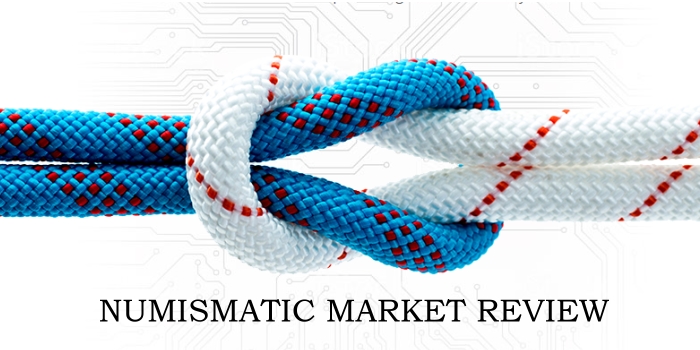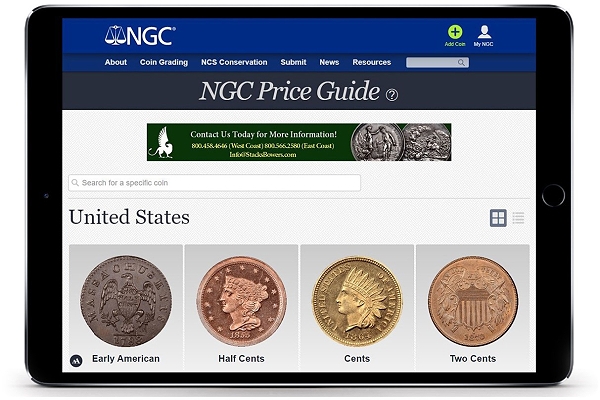Numismatic Market Review notables share their observations, predictions and recommendations to usher the hobby into the new year
Numismatic Market Review by Jim Bisognani – NGC Weekly Market Report ……
First off, I hope that my fellow Coindexters are having a wonderful holiday season and that the coins of your dreams were waiting for you under the tree or perhaps in the toe of your Christmas stocking. For those recently converted to the ways of numismatic nirvana, a hearty welcome! As I type away, it is now the day after Christmas and as I gaze out my living room window at the modest snow cover, it is hard to fathom that there is less than a week remaining in 2019!
Because hindsight is “2020”, let’s look back at what we’ve observed in the past year. For those regulars who put up with my musings, you know how I like to indulge in an annual Numismatic Market Review ritual and share the wisdom of numismatic notables, both young and old. Yes, it is time for my Ninth Numismatic Market Review!
What has been the most significant change (or challenge) for you and your business this year?
Ian Russell – President and Owner, GreatCollections
“Our business has continued to increase — in total coins sold as well as the number of unique collectors we deal with on a weekly basis — so I guess my biggest challenge has been balancing the increase in workload, not just for me but also for our great team. Not only do we have the best team at GreatCollections, we have advanced systems that help us with the increase in business, so that has really helped us.”
Bob Green – Owner, Park Avenue Numismatics
“For my business, the most difficult issue has been procuring new clients that are looking to build collections of rare coins rather than collections of MS 70 and Proof 70 modern coins with interesting labels and signatures on them. The current base of rare coin collectors has diminished significantly in the last few years due to the release of all of the US Mint products and all the companies marketing that segment.”
Brian Hodge – Partner, LMRC
“Perhaps the most significant challenge this year has been navigating the further consolidation of the ‘retail’ coin market. These outlets are having an increasingly difficult time selling rare coins to end-users with the massive overload of conflicting data that is out there, from all the varying price guides to auction data. Why did one coin sell for this and another coin sold for that? It’s the perennial question.
“An informed customer is important, but I think what many people have been attempting to do by adding all this conflicting data out there has actually somewhat backfired, causing so much confusion that it’s actually kept some customers away. As an industry, we need to tidy it up. NGC seems to have its eye on the ball and has always been a leader in the consistency of its pricing data.”
John Brush – President, DLRC
“The coin market certainly has its ebbs and flows, but we thought that 2019 was a stronger year overall, with some really interesting rarities that we were able to handle. Amongst them were the 1885 Proof Trade Dollar, an 1894-S Dime, and a few other pieces. These were certainly enjoyable aspects of the year. But the biggest challenge that I can foresee that really began this year was the added South Dakota versus Wayfair tax issue. This is going to be a challenge for the overall hobby and one that isn’t going away without some strong support from the collector and dealer community.”
Ira Goldberg – Co-Owner, Goldberg Coins & Collectibles
“We have witnessed some dramatic changes in the coin market this year. The most significant change is the rise of social media retail. Years ago, the introduction of the internet to the coin business shook the market for a while but did not completely change the roles of practitioners in the industry. However, this time, with the larger quantities of transactions being processed every day on social media, I feel that the coin market will finally experience some deeper restructuring.
“With the convenience of posting coins onto social media platforms (Facebook, Instagram, etc.) for retail/auction, any collector should be able to trade coins. The traditional costs of cataloging, promoting and advertising are lowered to a minimum, and the cycles of payment-shipping-receiving-confirming is nonexistent. The transactions can be completed significantly faster. Compared to this, even eBay’s 5-7 auction seems ‘old-fashioned.’ This can be clearly seen in our trade publications, which are shrinking monthly. For example, a full-page ad in one of the two leading trades costs around $3,000 per issue. For a fraction of the cost, a person can reach a far more targeted audience and know its effectiveness far quicker.
“However, the future for social media-based trading is uncertain to me. It will take years for us to understand how social media influences the coin market. It may challenge the current industrial regulations and ethics, but we don’t have an answer to that yet.”
Jim Stoutjesdyk – Vice President of Numismatics, Heritage Auctions
“Coin prices and valuation seem to have dominated much of the conversation in the rare coin market this year. Values for mainstream coins such as common to slightly better silver dollars and type coins seem to continue sliding downward as the market tries to adjust to the ever-increasing supply of graded coins, ‘grade-flation’ and lower demand by collectors for common material that every dealer seems to have.
“In contrast, values for truly scare and rare coins, coins with exceptional eye appeal and coins that are premium quality for the grade seem to be steadily rising. So, as the market tries to sort out this dichotomy of some prices rising while others are falling, the Greysheet has been more accurately reporting all of this. Unfortunately, the number of coins falling seems to outnumber the coins that are rising, making the market appear softer when looking at Greysheet bid levels as a whole. 2019 has definitely been a very tricky market to navigate through!”
Adam Biagi – Owner, Pacifica Trading Company
“The most significant challenge is probably the implementation of the new sales tax rules after the Supreme Court decision on South Dakota versus Wayfair.
“As an online seller, it’s created a whole new level of bureaucratic hoops that we have to jump through to do just the basic stuff that we were normally used to. Poor guidelines and implementation have exacerbated this issue. With what I sell, I haven’t seen a terrible impact but there is a definite impact to be seen, most notably on numismatic, non-bullion-related material. It probably affects the US much more than it does the foreign market, simply due to higher prices on US material in general.”
The US “Type Coin” and “Classic Commemorative” markets have been lackluster for several years. Do you believe there are still good values in these market segments?
Kevin Stoutjesdyk – Price Analyst, Numismatic Guaranty Corporation
“I am not the biggest fan of ‘Type Coins,’ and I believe there are better options to explore when buying. That said, they still have potential in this current market. With the prices being stagnant or even dropping, you can find some quality coins at a bargain if you are patient and do some research. The key here is finding the coins on the border of being type and finding the grade that has the most bang for your buck.
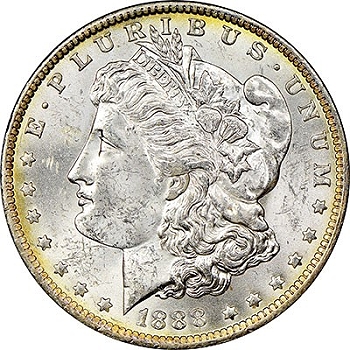 “Take for example the 1888-O Morgan Dollar, a readily available year with an NGC population of almost 30,000. With some digging, you can find an exceptional MS 65+ for roughly $500. That coin would be tied with 15 and only 58 are finer. So, for your $500 investment, you now have one of the top-100-graded NGC Morgans for that year and mint.
“Take for example the 1888-O Morgan Dollar, a readily available year with an NGC population of almost 30,000. With some digging, you can find an exceptional MS 65+ for roughly $500. That coin would be tied with 15 and only 58 are finer. So, for your $500 investment, you now have one of the top-100-graded NGC Morgans for that year and mint.
“Now compare that to an extremely common 1881-S with a total pop of 260,000, and you can find a little nicer coin in MS 67 for a hundred dollars more at $600. However, that MS 67 will be tied with more than 4,000 others and have more than 500 graded higher. That is why I would stress avoiding the highest population coins when buying type and look for the coins that are on the margin of type.”
Adam Biagi
“It may be a buying opportunity, but it’s difficult for dealers to tie up large amounts of cash in Type inventory in the $500 to $5,000 range. The big auction companies are dumping way too much of the stuff on the market, and it seems that APRs continue to decline.
“Another problem is that most of the auctions in which these coins are sold are held late in the evening after large shows and in rapid-fire succession. Most dealers who would normally buy the stuff are too busy focusing on their primary business at the show rather than trying to compete for items in regards to price support. This creates a negative feedback loop that will be hard to stop. As far as classic commemoratives go, it’s going to get significantly worse. There are certain commemoratives that have almost no spread between XF and MS 66, which is quite telling.”
John Brush
“Honestly, I don’t think the market has been ‘lackluster’ in these series. However, when there are so many coins on the market with below-average eye appeal, the prices will get pushed down when sold in an open market. The eye-appealing pieces and upper-end examples that we have handled have held their value quite well. It simply comes down to quality and how the coins are presented in the long-run. If you dump a large number of unattractive coins (or simply too many of any example) onto the market, it’s going to have a hard time absorbing the waves.”
Ian Russell
“Yes, most definitely. Some really intelligent people focus on the areas with the least interest, or that are neglected. Classic commemoratives offer great value, as there are coins in the $150 to $300 range that historically traded for much more. On the other end of the market, I think you will find many examples of increasing prices for the high-grade silver commemoratives in the past six months.”
Brian Hodge
“Yes, absolutely. Generic Type coins have appeared to be excellent values for a while now. Classic commemoratives also seem like good buys in this market relative to many of their mintages and populations.”
Bob Green
“I do believe that the classic commemorative market is a greatly undervalued market segment that has been overlooked for too long and represents great value for investors. My reasoning is that they’re just not making them anymore and in some cases, the messages and the history of these commemoratives make them worthwhile collectibles for anybody entering the market.”
Jim Stoutjesdyk
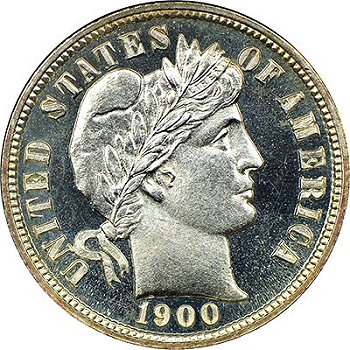 “Absolutely! Take Proof Barber dimes for example. Most of the dates in the series have mintages under 1,000, so they are inherently scarce. This past year, I’ve seen PF 67 Barber dimes trade in the $1,250 to $1,350 range. Granted, these aren’t the most attractive coins, but when the less-attractive coins sell at these cheap levels, it tends to pull down the level of even the nice coins. So, decent coins can be found in the $1,500 to $1,800 range, and when you look at prices 10 years ago, in 2009, they were selling for $2,500 to $3,500. They are now trading for half of those levels, which seems like good value.
“Absolutely! Take Proof Barber dimes for example. Most of the dates in the series have mintages under 1,000, so they are inherently scarce. This past year, I’ve seen PF 67 Barber dimes trade in the $1,250 to $1,350 range. Granted, these aren’t the most attractive coins, but when the less-attractive coins sell at these cheap levels, it tends to pull down the level of even the nice coins. So, decent coins can be found in the $1,500 to $1,800 range, and when you look at prices 10 years ago, in 2009, they were selling for $2,500 to $3,500. They are now trading for half of those levels, which seems like good value.
“I’m not sure that classic commemoratives will ever make a strong recovery, but bargains exist now in many coins that are trading at just a fraction of what they were 10 to 20 years ago. I recently purchased a nearly white MS 65 Sesqui for $750, and that is about a third of what the coin would have sold for 10 years ago.”
Dave Bowers – Numismatist, Author and Co-Founder, Stack’s Bowers Galleries
 “Per my studies, the prices of federal Type coins peaked in August 2013. At that time, I mentioned to Christine Karstedt that if we had a Gem Proof 1879 Flowing Hair $4 Stella in an auction, we would have a half dozen or more bidders chasing it past $200,000. Today, the typical auction price is apt to be slightly below that figure, with fewer bidders. There are exceptions, of course, especially if two or more bidders feel it would upgrade if recertified.
“Per my studies, the prices of federal Type coins peaked in August 2013. At that time, I mentioned to Christine Karstedt that if we had a Gem Proof 1879 Flowing Hair $4 Stella in an auction, we would have a half dozen or more bidders chasing it past $200,000. Today, the typical auction price is apt to be slightly below that figure, with fewer bidders. There are exceptions, of course, especially if two or more bidders feel it would upgrade if recertified.
“Across the board, Proof Liberty Seated and Barber coins are lower — attractively so, it would seem. At a convention, I discussed this with Laura Sperber, who estimated that a complete set of PF 65 Barber dimes, quarters and half dollars could be bought for under $100,000. As I write this, I recall in early 1980 — and that was 40 years ago — a client of mine, Dr. Collier, had a set of Proof Barber half dollars in 65 grade, and he had been offered $15,000 per coin for them. Many of us remember the height of the market for classic silver commemorative half dollars in 1989; today, prices are fractions.”
What are your recommendations for inspiring and drawing new collectors to the hobby?
Lianna Spurrier – Numismatist, Author and Videographer, CoinMediaByLianna.com
“I think the first step to expanding the hobby is to modernize — embrace social media and the internet — which I’ve seen quite a few steps toward. It needs to be accessible for anyone, regardless of whether or not they live near a coin shop or any major coin shows.
“The next thing I believe we need to do is to simply get it in front of as many people as possible. Share with them that we exist, and show them some of the benefits of the hobby. I believe that a lot of people, particularly younger generations, simply haven’t considered it as an option. Perhaps they believe it has to be expensive or perhaps they don’t even understand that there’s a whole community of us out here. Either way, finding a way to get the hobby in front of more people in a positive light is something we should address.”
Kevin Stoutjesdyk
“I’ve always tried to use three main topics to draw people into the hobby, those being history, money, and art. It is pretty common for numismatists to share an interest and appreciation for history, and that correlation can be used to bring new people into the hobby. That is why it might be fairly easy to get a Civil War memorabilia collector interested in coins by simply using a shared item like Civil War tokens to spark interest.
“Besides history, a lot of people may be brought into numismatics because they’re looking for a side job or way to invest for the future. A lot of business-minded people can see the potential in learning numismatics and often silver and gold investors start collecting non-bullion coins after learning more about them. It is important, however, to stress getting educated before jumping into any major purchases.
“Lastly, it is possible to use similarities between numismatics and the art market to garner new interest. A love for Neoclassicism and a dinner conversation with Saint-Gaudens led Theodore Roosevelt to overhaul longstanding US Mint designs. If that can happen, then is it too far of a stretch to think an art collector might be interested in collecting something like Gothic Crowns? The overall trend here is to just find common ground so you are not creating interest from scratch but building on something that is already there.”
John Brush
“This hobby has several different strata of collectors. However, the thing they all have in common is a love for coins. I think that there are many different ways of bringing these collectors together, but broadcasting the hobby to the largest number of people possible is a great start. Expanding the large show footprint to cities throughout the United States, projects like the Great American Coin Hunt and other things that bring mainstream media to the hobby are an absolute must.
“However, the division between organizations, dealers and the peripherals needs to go away. If the entire hobby worked together to promote the hobby and to encourage collecting, I think it would go a long way. We have to treat collectors as we’d want to be treated in their shoes. Unfortunately, I think we overlook the value of collectors, and many dealers and organizations just want to pursue a greater bottom-line profit. However, the collector is of the utmost importance, whether they spend $20 or $20,000,000!”
Brian Hodge
“Make Coins Great Again. Seriously, I think modern coin programs help, but it is the retail companies once again who are reaching many of these end-users who are putting up advertising dollars to reach these market sectors. Those end-users often end up navigating around to rare coins once they have the money to do so. Also, if we can make coin shows an experience again, I think it would help.”
Jim Stoutjesdyk
“The State Quarter series was probably the best thing the US Mint has done in years to get people to start collecting coins from circulation. Similar programs could inspire more people to start collecting coins. Bringing coins into schools is probably the best way to inspire young people to have an interest in numismatics. Local coin clubs need to work with schools in their area to present educational programs and teach kids about coin collecting.”
Adam Biagi
“My greatest recommendation is to engage new collectors at shows. I remember what it was like to be a young collector and to be ignored or even ripped off by dealers who I only knew through advertisements in the trade publications. It was like meeting a celebrity and being completely disappointed each time.
“Today, there is more active engagement with younger collectors at a level that I can’t ever remember seeing. If anybody tells you that this is a hobby for old men, they’re only partially correct. What they are not seeing is the younger generation.
“One drawback is that, 20 years ago, an hour’s minimum wage would have bought you more than an ounce of silver, and a few weeks’ hard work for a youngster would yield some fairly decent Type coins. Right now, almost everything is priced out of the youngsters’ reach, and an hour at minimum wage would only buy you half an ounce of silver. While we can’t control the commodity markets, this is to the detriment of the hobby.”
Ian Russell
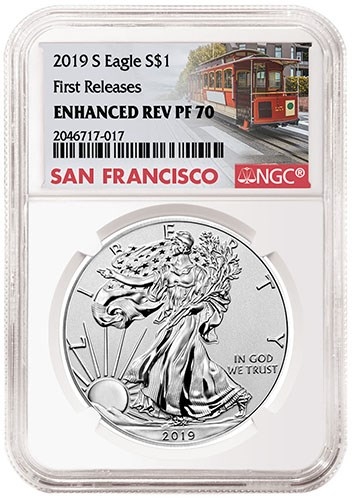 “The US Mint is trying different things. The 2019-S Enhanced Reverse Proof Silver Eagle is likely going to bring new collectors into the market. If you deduct the number of coins purchased by coin dealers and their ‘networks,’ any end-user that was lucky enough to buy a coin for $70 that trades at over $2,000 is going to be a long-term collector. But perhaps that’s cheating because that’s a lot of money to gift someone to collect coins!
“The US Mint is trying different things. The 2019-S Enhanced Reverse Proof Silver Eagle is likely going to bring new collectors into the market. If you deduct the number of coins purchased by coin dealers and their ‘networks,’ any end-user that was lucky enough to buy a coin for $70 that trades at over $2,000 is going to be a long-term collector. But perhaps that’s cheating because that’s a lot of money to gift someone to collect coins!
“I liked the concept of the W quarters that were released in circulation, which should help long-term. A dealer was just telling me at the Baltimore show his suggestion to the US Mint about producing 2020 Buffalo Nickels in the original design/style/metal that looked like they were from 100 years ago — and putting those in circulation. That would make major headlines and new collectors of coins.”
Bob Green
“There are two ways in which to inspire: one is profit potential, which can be a slippery slope, and the second is an earnest desire to enjoy the hobby of collecting rare coins. Over my career, I’ve dealt with both kinds of clients and have found that the coin collector who wants to build a collection and hold onto coins for a long time ends up being both. The problem with investors is markets are cyclical and timing must be correct. The same buyers of $20 gold pieces purchased as an investment in 2011 are not so bullish right now, with the same coins trading for $1,550. However, properly selected rarities with low populations and accreditation have performed quite well in the same time.”
Any personal remembrances, stories or anecdotal holiday memories relating to our great hobby?
Adam Biagi
“My holiday coin memory: When I was a kid I used to really enjoy the 1970 version of Scrooge with Albert Finney. The opening scene was a gentleman tossing a handful of tuppences to a group of carolers, followed by a scene of Scrooge, himself, counting sovereigns. I remember as a kid always wanting to have all those sovereigns.”
Jim Stoutjesdyk
“My father began collecting coins in the 1950s and found most of the coins for his blue Whitman folders in circulation, including a 1916-D Mercury dime he got in change working at a movie theater concession stand. One of the few coins he never found in circulation was a 1909-S VDB cent.
“In the 1980s, I was with my grandparents at a mall (yes, people actually went to malls in the 1980s!) and in the middle of the mall was a used book sale benefiting some community charity. Among the used books, I found a first edition Redbook that I excitedly purchased for fifty cents. I sold that Redbook for $250 and bought my father the 1909-S VDB cent that he needed for his collection.
“My father passed away in October, but I still have that 1909-S VDB cent and I look upon it fondly and remember the joys I had collecting coins, which led me to eventually become a professional numismatist.”
* * *
Wow, quite enlightening and so much more to come! Stay tuned for the Ninth Annual Market Review – Part 2 next time!
Until then, happy collecting and Happy New Year!
Jim Bisognani is an NGC Price Guide Analyst. He has written extensively on US coin market trends and values.
Want to see more articles like this? Subscribe to the free NGC Weekly Market Report.
Jim Bisognani is an NGC Price Guide Analyst having previously served for many years as an analyst and writer for another major price guide. He has written extensively on US coin market trends and values.


